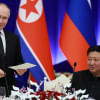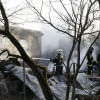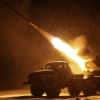Russia's growth dips as inflation weighs on economy

Russia's growth slowed in the third quarter, official statistics published Wednesday showed, with high inflation caused by the Kremlin's massive spending on the Ukraine offensive weighing on the economy.
Moscow has militarised Russia's economy since it launched its full-scale offensive of Ukraine in February 2022, with huge outlays on soldiers and weapons powering its economy, but causing prices in the shops to rise fast.
Growth in the third quarter was 3.1 percent year-on-year, the Rosstat federal statistics agency said, down from a rate of 4.1 percent in the second quarter.
Inflation, meanwhile, came in at 8.5 percent in October, down from 8.6 percent a month earlier, but still well above the state's official 4.0-percent target.
The Kremlin has boasted of defying the West's attempts to collapse Russia's economy through sanctions, pointing to rapid growth since it ordered troops into Ukraine.
Experts say the government's massive spending on the military campaign that is spurring the economy, leaving many parts of the civilian sector behind.
The International Monetary Fund recently raised its forecast for Russia's 2024 growth to 3.6 percent.
But it said the economy would slow next year to just 1.3 percent amid mounting problems.
- 'Large labour deficit' -
Russia's spending on defence and security will account for 8.7 percent of GDP in 2024, President Vladimir Putin said earlier this year.
That is the highest level since the end of the Cold War.
Moscow is set to hike defence expenditure by another 30 percent next year, according to official budget plans.
The booming expenditure has shielded Russia's economy from predictions it could face a years-long recession after it ordered troops into Ukraine and was hit with Western sanctions.
But it has also triggered inflation and massive labour shortages at home.
Hundreds of thousands of men have been called up to fight, fled the country or been recruited by weapons makers -- leading to a cycle of spiralling wages and prices that the central bank has warned undermines stability.
Putin admitted last week the country faced a "large labour deficit," with unemployment at a record low and several sectors struggling to recruit.
The Central Bank also warned this week that inflation was staying stubbornly high even after it hiked interest rates to 21 percent, their highest level in more than two decades.
"If we look at the picture for the last month or two, this is a picture of quite stable, fast price growth. It is difficult to see any significant change in inflation dynamics so far. Inflation is still at a high level," Alexei Zabotkin, the bank's deputy governor said.
Rising prices for household staples like butter and sunflower oil have become national headline news inside Russia in recent week -- reminiscent of a panic over rising egg prices last year.
Russian society is particularly sensitive to high inflation and volatile food prices, given the country's history of economic crises and, during the Soviet Union, food shortages and rationing.
Despite raising interest rates to bring down price rises, Central Bank Governor Elvira Nabiullina has repeatedly said they are a less effective tool because of the government's massive spending surge.
Higher borrowing costs work to cool demand by making it more expensive for businesses and individuals to take out loans, and more profitable to save.
But government spending, especially on the Ukraine campaign, is not swayed by higher borrowing costs.
Despite some economic headwinds, independent economists largely agree Russia has the resources and flexibility to carry on fighting Ukraine for at least the next few years.
The country has low government debt, around 15 percent of GDP, is set to post a deficit of below 2.0 percent for this year, and has pushed through billions of dollars worth in tax rises to help fund the military campaign.

 For all latest news, follow The Daily Star's Google News channel.
For all latest news, follow The Daily Star's Google News channel. 








Comments